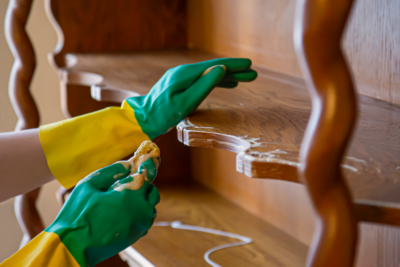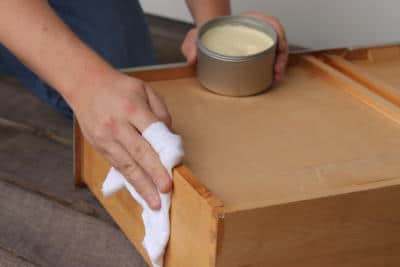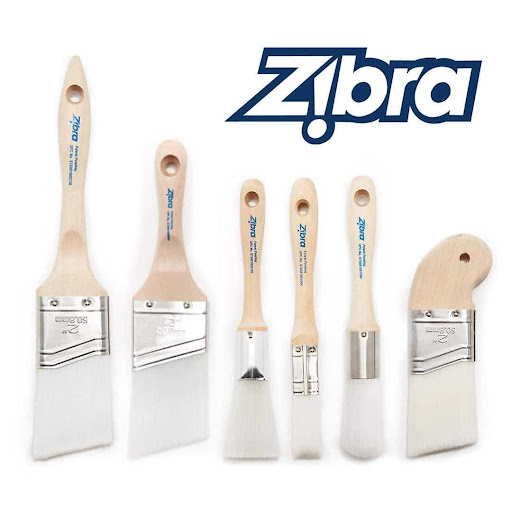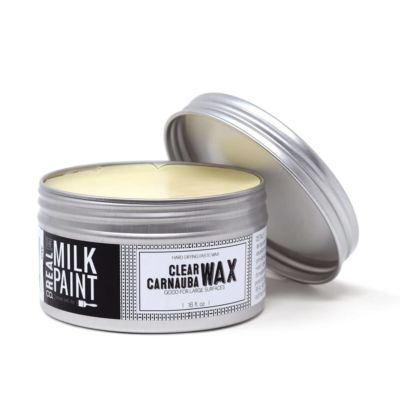When you want to give painted furniture a timeless patina of age without a lot of work, applying dark wax to antique your piece may just be the way to go. Fast and easy to use, waxes like Good Ol’ Brown Wax by the Real Milk Paint Co or the Clear Soft Waxes come in a range of colors — from clear to black wax — so you have versatile color options for distressing your furniture makeovers.
Whether you’re chalk painting your kitchen cabinets or refinishing a piece of furniture with milk paint, these top coat waxes not only complete the look of your antiqued DIY project but also imbue durability and strength to the finish itself.

Reasons for Antiquing Furniture with Paste Wax
Antiquing furniture with wax like Zero VOC Wax from the Real Milk Paint Co. adds flair to painted furniture and also serves as a tough top coat. But other reasons for antiquing with dark wax exist aside from just finishing a piece of furniture.
Draws Attention to Detailing
Using dark wax over carved details helps you easily create a well-aged look with just a little rubbing. From hand-carved floral accents and decorative motifs to recessed areas and ship lapped planking, a little dark wax fills in the cracks and crevices to showcase the details in their best possible light. In fact, the more ornate the piece of furniture, the better the typical results thanks to the way antiquing wax settles in the grooves.
Adds Depth to Laminate Pieces
Sometimes you have older pieces you’d love to refinish but simply can’t due to the limited amount of work you can do with wood laminate. In those cases, however, using a colored furniture wax like Soft Wax to antique the material instead of taking risks with sanding and repainting can aid you in transforming drab and dated pieces into fun pieces that mesh well in modern homes.
Helps Harmonize Hues
If you choose two shades of paint that complement each other better in the can than on your DIY project, antiquing with dark waxes can help harmonize the hues. A tinted wax somewhere between the two colors minimizes differences between disparate hues to help you attain a well-blended look. Additionally, using warmly tinted wax over cool paint colors or cool tinted wax over warm paint colors let you easily rebalance projects without repainting them.
Enhances Wood Grain
When you’re distressing furniture you’ve painted and sanded down a bit, dark wax can help enhance the look of the wood grain to help you achieve a more rustic visual effect. Rubbing down a piece of furniture you’re refinishing with a complementary tinted wax pushes color into the crevices to make the natural wood texture stand out more and imbue an aged feel. Want to create a light and airy feel? Try using our White Soft Wax on raw wood!
Tips for Antiquing Furniture with Wax
Now that you know when to apply wax for antique furniture, you need to know how to use this medium to your best advantage. These tips line out best uses for various types of furniture wax by the Real Milk Paint Co. and how to use them to get the look you want for your DIY projects.

1. Work in Small Sections
When buffing furniture wax into a painted surface, work the medium into small rather than broad sections. Keeping your work area small lets you see the results as you brush on the dark wax and wipe it off with a clean, lint-free soft cloth, so you know what to expect as your DIY project progresses, and it also prevents the dark wax from drying out as you work. Additionally, working in small sections gives you ample time to change up your technique if something isn’t working.
2. Choose Soft Waxes for Easier Application
Buffing wax into painted furniture can be quite a chore, so it helps to work smarter and not harder by choosing soft waxes. For example, the Real Milk Paint Co. makes Soft Wax in an array of shades, including clear wax, ideal for antiquing and distressing furniture, and it’s made with beeswax and carnauba wax for an all-natural refinishing option that contains no VOCs.
 3. Apply Antiquing with a Wax Brush
3. Apply Antiquing with a Wax Brush
While you can certainly apply antiquing dark wax with a lint-free cloth, a special paintbrush for furniture wax makes the process much easier. The bristles of furniture wax brushes help with the process of getting dark wax color into the crevices and grooves of painted furniture, ensuring an even application. For tighter areas, consider using a smaller chip brush to achieve excellent coverage.
4. Mix Waxes for Customized Antiquing
If you can’t find the hue you want among the Real Milk Paint Co.’s range of furniture waxes, consider mixing your own using colors that almost suit your painted furniture. For example, use white or gray waxes to tone down black or dark wax colors, or add a darker shade to clear furniture wax to get a soft, subtle tint that works for your home décor.
5. Focus Antiquing Wax on the Details
While it might be tempting to cover your entire piece with distressing furniture wax, you want to focus your attention on the details. Concave areas with carvings provide the best opportunities for antiquing since those are the places time weathers the most, leaving recessed areas darker to capture natural shadows.
6. Fix Mistakes with Clear Wax

Even if you’re using dark distressing wax to antique your painted pieces of furniture, clear wax can come in handy as you work. This is because clear wax applied over dark wax pulls up the first layer so you can correct mistakes as you go with minimal effort. Simply apply the clear wax over the waxed piece area you darkened too much, wipe away the color and then start again.
Completing furniture makeovers or furniture refinishing with the best wood wax from the Real Milk Paint Co. usually proves a quick, simple process, and knowing some tips and tricks to help the process along boosts your confidence. No matter if you’re refinishing your kitchen cabinets, redoing an old dresser with chalk paint or upcycling a garage sale cabinet you got for a song, using dark wax to antique the piece of furniture brings visual interest and unique style to your home décor.



